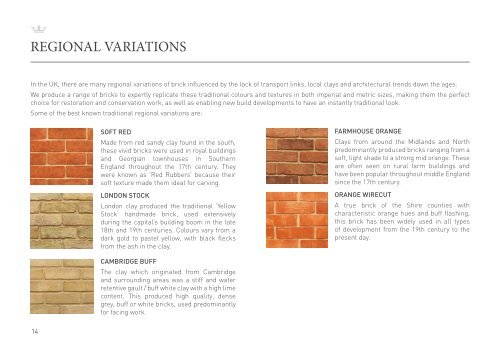Imperial Bricks Brochure 2018 - III
A comprehensive guide to the extensive product range from Imperial Bricks, which includes 50+ handmade, wirecut and pressed bricks and brick slips, pavers and specials. The brochure features information on lime mortar and brick weathering tints, along with the extensive range of support services on offer, such as expert brick matching, bespoke weathering and creating custom blends.
A comprehensive guide to the extensive product range from Imperial Bricks, which includes 50+ handmade, wirecut and pressed bricks and brick slips, pavers and specials. The brochure features information on lime mortar and brick weathering tints, along with the extensive range of support services on offer, such as expert brick matching, bespoke weathering and creating custom blends.
Create successful ePaper yourself
Turn your PDF publications into a flip-book with our unique Google optimized e-Paper software.
REGIONAL VARIATIONS<br />
In the UK, there are many regional variations of brick influenced by the lack of transport links, local clays and architectural trends down the ages.<br />
We produce a range of bricks to expertly replicate these traditional colours and textures in both imperial and metric sizes, making them the perfect<br />
choice for restoration and conservation work, as well as enabling new build developments to have an instantly traditional look.<br />
Some of the best known traditional regional variations are:<br />
SOFT RED<br />
Made from red sandy clay found in the south,<br />
these vivid bricks were used in royal buildings<br />
and Georgian townhouses in Southern<br />
England throughout the 17th century. They<br />
were known as ‘Red Rubbers’ because their<br />
soft texture made them ideal for carving.<br />
LONDON STOCK<br />
London clay produced the traditional ‘Yellow<br />
Stock’ handmade brick, used extensively<br />
during the capital’s building boom in the late<br />
18th and 19th centuries. Colours vary from a<br />
dark gold to pastel yellow, with black flecks<br />
from the ash in the clay.<br />
FARMHOUSE ORANGE<br />
Clays from around the Midlands and North<br />
predominantly produced bricks ranging from a<br />
soft, light shade to a strong mid orange. These<br />
are often seen on rural farm buildings and<br />
have been popular throughout middle England<br />
since the 17th century.<br />
ORANGE WIRECUT<br />
A true brick of the Shire counties with<br />
characteristic orange hues and buff flashing,<br />
this brick has been widely used in all types<br />
of development from the 19th century to the<br />
present day.<br />
CAMBRIDGE BUFF<br />
The clay which originated from Cambridge<br />
and surrounding areas was a stiff and water<br />
retentive gault / buff white clay with a high lime<br />
content. This produced high quality, dense<br />
grey, buff or white bricks, used predominantly<br />
for facing work.<br />
14





